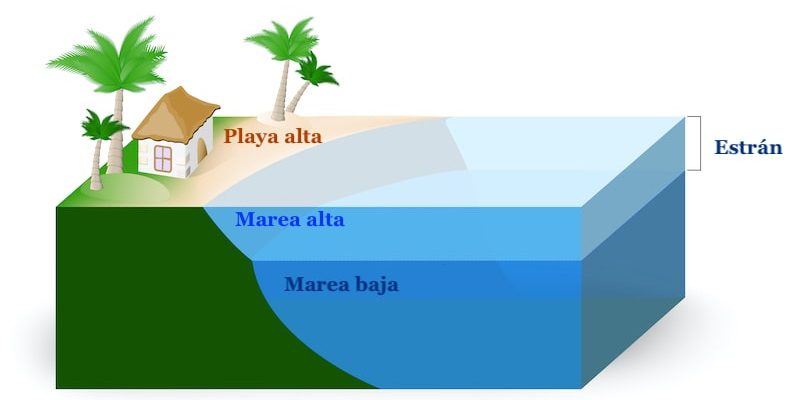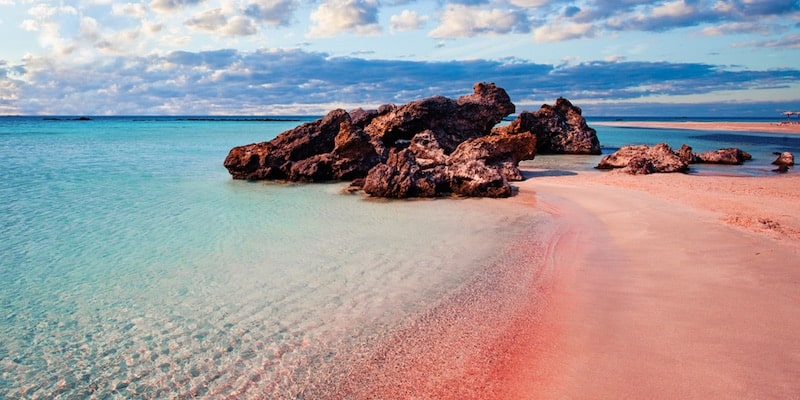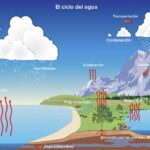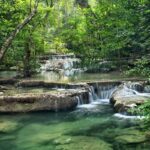We explain everything about the beaches, how they are formed and which are the most famous. In addition, we tell you why it is important to preserve them.

What is a beach?
A beach is a geographical feature, that is, one of the forms that the terrestrial terrain acquires, which It is made up of a large set of rock sediments (sand, gravel, pebbles, etc.) or of biological origin (shells, remains, etc.) that are deposited on the slope of the seashore or a lake
The specific shape of a beach depends on the way waves, tides and local climate act on its materials, since The action of the elements shapes the slope and determines the type of sediments found. There are beaches with very steep slopes, where significant depths are reached quickly, and others, on the other hand, are very flat, extending shallowly for dozens of meters.
From a biological point of view, beaches make up an important part of the coastal ecosystem, since they are a point of contact between marine and terrestrial species and often host their own fauna and flora, despite the fact that it is a dynamic and continually changing environment. Different species of crustaceans and bivalves live in sand or rocks, while numerous birds, mammals and even reptiles lead an amphibious life between land and water.
About a third of the world's coasts are occupied by sandy beaches which play an important role in recreation and fishing, as well as other human cultural and economic activities. For this reason, they are also an environment strongly impacted by human presence, especially pollution, although there are still virgin or wild beaches that have not yet been discovered or inhabited by humans.
How are beaches formed?

The geological formation of beaches occurs when there are more materials available on the Earth's surface than the waves can move and marine currents, and therefore are deposited in the intermediate region between water and land. Thus, two regions are clearly differentiated from any beach:
- The low beach or foreshore which is completely submerged by water and whose normally gentle slope leads towards the oceanic plain.
- The high beach or upper part which is above sea level forming a coastal range with a variable slope, generally steeper and equipped with steps.
Furthermore, the intermediate region between the two, between the levels of high tide (high tide) and low tide (low tide), is known as estran. In this region the waves push the sediments outwards and the surf pulls them back in, in a continuous movement of utmost importance for the formation of sand.
The formation of beach sediments is due to erosion and the action of the elements on the rocky materials of the coast, or the accumulation of waste of organic origin like seashells. In any case, these sediments accumulate and are eroded by the continuous force of the water, thus producing sand of different degrees of thickness, and of different colors, textures and properties, depending on its nature.
Types of beaches

From a geological point of view there are three types of beaches:
- Blocked beaches arising as a sedimentary strip behind a rocky cliff, and which are arranged perpendicular to the average wave. They tend to be very unstable beaches, in which the sedimentary contribution is continuous.
- Free beaches arising at the end of a plain where marine or fluvial accumulation of sediments occurs, generally due to the slowing of the current or the action of different coastal geographical features.
- Long coastal beaches arising along kilometers parallel to the geography of the coast, forming long but narrow sedimentary strips of peculiar appearance.
On the other hand, from the point of view of the type of sediments that constitute them, we can distinguish the following types of beaches:
- White sand beaches composed mainly of quartz, limestone, iron, gypsum and feldspar sediments. They predominate in intertropical basins, such as the Mediterranean.
- Seashell beaches also whitish in appearance, are composed mainly of calcium carbonate extracted from the shells of mollusks, corals and the bones of marine animals, ground by the action of the elements. They predominate in the tropical region, such as the Caribbean.
- black sand beaches also known as volcanic beaches, are composed of basalt and obsidian sediments. They predominate in regions of great geological activity, such as the Canary Islands or the Galapagos Islands.
- Coral beaches equipped with pink sand, obtain their sediments from the erosion of coral remains, rich in calcium carbonate. They tend to be abundant in regions with important coral reefs, such as the Bahamas or Bermuda.
- Red sand beaches composed of sediments that come from oxidized volcanic rocks after long exposure to the air, as occurs on Kokkini Beach in Santorini.
- Green sand beaches composed of sediments rich in the mineral olivine, separated by erosion from the rest of the volcanic materials. The best example of this rare type of beach is Papakolea Beach in Hawaii.
Importance of beach conservation
The destruction and pollution of beaches It represents an ecological and economic tragedy of great proportions. On the one hand, it limits or prevents the possibility of recreational enjoyment or use as a food source for local communities, which contributes to the economic impoverishment of people. Polluted beaches are also a source of diseases for their visitors and for those who feed on fishing.
From an ecological point of view, beach pollution attacks marine ecosystems. The presence of waste materials harms local species and reduces biodiversity, promoting the uncontrolled growth of algae, for example, which leads to deoxygenation of the water (as algae compete with each other, die and decompose en masse). ) and the death of other species.
The most famous beaches in the world

Among the most famous beaches in the world are the following:
- Sarakiniko beach, Milos, Greece.
- Morrocoy National Park, in Falcón, Venezuela.
- Playa del Carmen, on the Yucatan Peninsula, Mexico.
- San Blas Beach, in Panama.
- Elafonisi Beach, Crete, Greece.
- Cathedral Cove, New Zealand.
- Baia do Sancho, in Fernando de Noronha, Brazil.
- Escondida Beach, in Marietas Islands, Mexico.
- Gardner Bay, in the Galapagos Islands, Ecuador.
- Reynisfjara, Iceland.
- Koh Similan, Thailand.
- Key Largo, in Cuba.
- Los Roques, in Venezuela.
- Ke'e Beach, Hawaii.
- La Digue, in the Seychelles Islands.
- Cox's Bazar, Bangladesh.
Continue with: Archipelago
References
- “Beach” on Wikipedia.
- “The importance of beach protection” at the United States Environmental Protection Agency.
- “Littoral Geomorphology” at the Catholic University of Chile.
- “Beach (geology)” in The Encyclopaedia Britannica.





